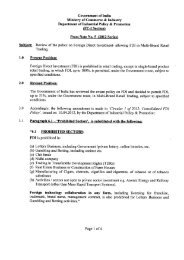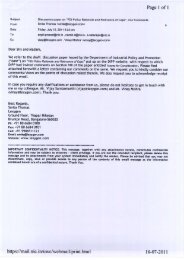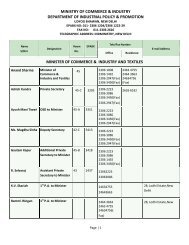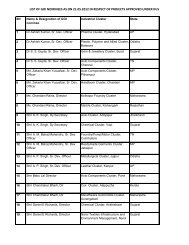fdi in india and its growth linkages - Department Of Industrial Policy ...
fdi in india and its growth linkages - Department Of Industrial Policy ...
fdi in india and its growth linkages - Department Of Industrial Policy ...
Create successful ePaper yourself
Turn your PDF publications into a flip-book with our unique Google optimized e-Paper software.
sector, non-profit <strong>in</strong>stitutions serv<strong>in</strong>g households sector, <strong>and</strong> the household sector. Enterprises can fall under any of these<br />
five sectors, <strong>and</strong> could be direct <strong>in</strong>vestors s<strong>in</strong>ce any resident unit may own or control a non-resident unit that qualifies<br />
as a direct <strong>in</strong>vestment enterprise. However, enterprises covered under the non-f<strong>in</strong>ancial corporation sector or the<br />
f<strong>in</strong>ancial corporation sector can only be foreign direct <strong>in</strong>vestment enterprises, because households <strong>and</strong> governments<br />
cannot be owned or controlled by non-resident un<strong>its</strong>. Further, non-profit <strong>in</strong>stitutions serv<strong>in</strong>g household sector may be<br />
established or owned by non-residents, but f<strong>in</strong>ancial transactions are not driven by <strong>in</strong>vestment considerations <strong>and</strong> thus<br />
they are not generally regarded as direct <strong>in</strong>vestment enterprises.<br />
8.5 Foreign Direct Investor-Foreign Direct Investment Enterprise Relationship<br />
As discussed elsewhere, to <strong>in</strong>clude f<strong>in</strong>ancial transactions or position as foreign direct <strong>in</strong>vestment, the two <strong>in</strong>stitutional<br />
un<strong>its</strong> should be resident <strong>in</strong> different economies <strong>and</strong> they should be <strong>in</strong> a direct <strong>in</strong>vestment relationship. A foreign direct<br />
<strong>in</strong>vestor is an <strong>in</strong>stitutional unit resident <strong>in</strong> one economy that has acquired either directly or <strong>in</strong>directly at least 10 per cent<br />
of the vot<strong>in</strong>g power of an enterprise or equivalent <strong>in</strong> an un<strong>in</strong>corporated enterprise that is resident <strong>in</strong> another economy.<br />
A direct <strong>in</strong>vestor can be an <strong>in</strong>dividual; a group of related <strong>in</strong>dividuals; an <strong>in</strong>corporated or un<strong>in</strong>corporated enterprise; a<br />
public or private enterprise; a group of related enterprises or a group of unrelated enterprises; a government body; an<br />
estate, trust or other societal organisation; or any comb<strong>in</strong>ation of the above. In the case of two enterprises each own<strong>in</strong>g<br />
10 per cent or more of each other’s vot<strong>in</strong>g power, each enterprise is an <strong>in</strong>vestor <strong>in</strong> the other.<br />
A foreign direct <strong>in</strong>vestment enterprise is an enterprise resident, whether <strong>in</strong>corporated or the equivalent for an<br />
un<strong>in</strong>corporated, <strong>in</strong> one economy <strong>and</strong> <strong>in</strong> which an <strong>in</strong>vestor resident <strong>in</strong> another economy owns either directly or <strong>in</strong>directly<br />
at least 10 per cent of vot<strong>in</strong>g power. The threshold ownership of 10 per cent vot<strong>in</strong>g power proves the existence of a direct<br />
<strong>in</strong>vestment relationship between the direct <strong>in</strong>vestor <strong>and</strong> the direct <strong>in</strong>vestment enterprise. It is important to identify the<br />
direct <strong>in</strong>vestment relationship <strong>in</strong> order to f<strong>in</strong>d the exact number of FDI-enabled enterprises to be <strong>in</strong>cluded <strong>in</strong> the FDI<br />
statistics of a particular economy.<br />
Further, it is important to consider the ownership stake of a direct <strong>in</strong>vestor <strong>in</strong> the ownership cha<strong>in</strong> <strong>and</strong> the <strong>in</strong>vestor’s<br />
relationship with an enterprise other than that of the orig<strong>in</strong>al enterprise <strong>in</strong> which 10 per cent vot<strong>in</strong>g power is held.<br />
Consider that there are Enterprises A, B <strong>and</strong> C <strong>in</strong> different economies. Suppose Enterprise A owns 70 per cent of the<br />
vot<strong>in</strong>g power <strong>in</strong> Enterprise B <strong>and</strong> is considered as a direct <strong>in</strong>vestor <strong>in</strong> B. Enterprise B, <strong>in</strong> turn, has 60 per cent of the<br />
vot<strong>in</strong>g power <strong>in</strong> Enterprise C <strong>and</strong> is considered as a direct <strong>in</strong>vestor <strong>in</strong> C. It is clear that A has control over B <strong>and</strong>, through<br />
<strong>its</strong> control over B, it has <strong>in</strong>direct control over C. Thus, f<strong>in</strong>ancial transactions between A <strong>and</strong> C should be relevant to<br />
FDI, even though A has no equity hold<strong>in</strong>g <strong>in</strong> C.<br />
Similarly, a direct <strong>in</strong>vestor may have control over more than one direct <strong>in</strong>vestment enterprise. For <strong>in</strong>stance, given the<br />
threshold vot<strong>in</strong>g power, Enterprise A can have control over B <strong>and</strong> C. While compil<strong>in</strong>g FDI statistics, it is important to<br />
take <strong>in</strong>to account the f<strong>in</strong>ancial transactions between B <strong>and</strong> C, even though there is no equity participation between<br />
them. Enterprise B may raise capital <strong>and</strong> lend to C at concessional rates because they are both controlled by A. That<br />
is, enterprise A, B <strong>and</strong> C are <strong>in</strong> a foreign direct <strong>in</strong>vestment relationship <strong>and</strong> B <strong>and</strong> C are considered as “fellow<br />
enterprises” of one another. Based on the percentage of equity participation <strong>in</strong> the foreign direct <strong>in</strong>vestment relationship,<br />
a direct <strong>in</strong>vestment enterprise can be called a subsidiary or an associate. 4<br />
8.6 FDI Data Report<strong>in</strong>g<br />
To record the direct <strong>in</strong>vestment between residents <strong>and</strong> non-residents, the Benchmark Def<strong>in</strong>ition recommends the use<br />
of two methods to account for the FDI data. They are the asset/liability pr<strong>in</strong>ciple <strong>and</strong> directional pr<strong>in</strong>ciple. Under the<br />
4. For more details, see OECD (2008), Chapter 3.<br />
FDI DATA REPORTING AND CLASSIFICATION<br />
93












